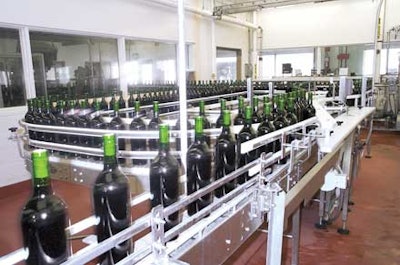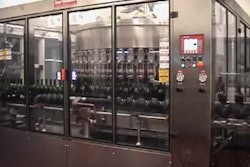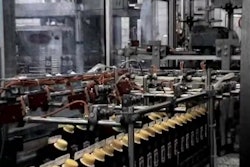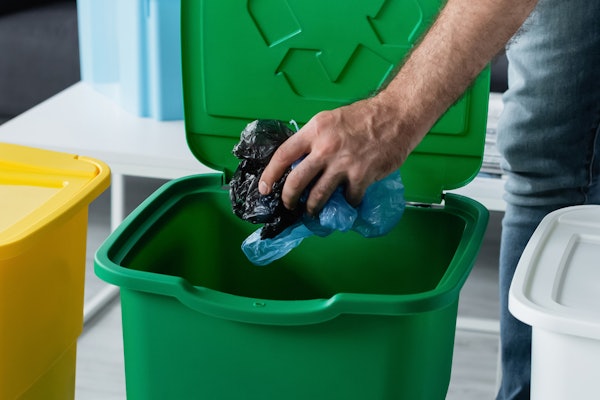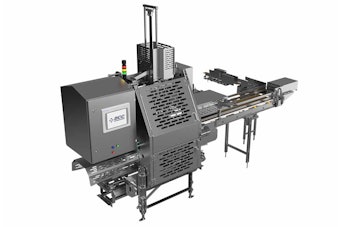Uptime is always at a premium, especially for Pacific Wine Partners, Gonzales, CA, bottlers of premium wines.
To address the ebb and flow of bottles that led to slowdowns and stoppages on a key production line, PWP installed two Infinity® accumulation systems from Garvey Corp. in late summer 2003. One is located between the filler and the capsule applicator-spinner, the other is positioned ahead of the case packer. Together, the accumulators keep the bottling line’s upstream and downstream operations running more reliably at higher speeds.
“It’s easy to see the buffer effects the tables provide,” observes PWP engineering manager Al Schroeder. “Each table gradually fills up, and gradually empties. They keep the line flow balanced and running.”
The 1/8” difference
What is especially noteworthy is that reverse-tapered bottles comprise about 85% of PWP’s bottling mix on this line, which yields 1.7 million cases of wine yearly. PWP’s bottles are only slightly tapered, 1/8’’ wider at the shoulder than at the base, but Schroeder says that’s all it takes to create major problems on conventional accumulators such as bidirectional units. Yet the tapered bottles present no problem for the Infinity systems, which permit zero-pressure conveying during temporary storage without falling bottles.
Before, line speeds were limited to 140 750-mL bottles/min, and were down to 120 bpm for the problematic tapered bottles. Since the accumulators were added, PWP operates the line at 180 bpm for either straight-walled or tapered bottles.
Production line efficiency has risen along with rates. Before, efficiency at the lower speeds peaked near 70%. Now, efficiency is “80 to 85%,” according to Schroeder.
During Packaging World’s visit, PWP produced 12-bottle trays of Blackstone-brand Merlot in 750-mL reverse-tapered bottles. Blackstone is the largest-volume red wine in its price category in the United States, and all of it is bottled on this line, Schroeder says. The operations cruise at 180 bpm for one to three shifts, five days per week.
The 4x3 reshipper traypacks for the day’s production run, done for club stores, are manually uncased. The bottles are nitrogen flushed before entering a separate room. The room houses a newly installed 54-valve Italian-made Bertolaso gravity-flow vacuum filler from ColloPack Solutions and the upstream accumulator.
“The filler offers faster speeds, less wine waste, and gentler filling with less dissolved oxygen than the prior 48-valve filler,” notes Schroeder.
Next, bottles are corked using a “new” Bertolaso unit bought from a winery that had kept the unit in storage for 20 years. Schroeder is especially proud of the find.
Three minutes’ difference
Bottles continue being conveyed in single file to the first Infinity accumulator. When there are no backups to the capsule applicator-spinner, bottles proceed directly through the accumulator. When backups occur, the 14’x6’ oval accumulator can hold up to five rows of bottles, or about three minutes’ production at 180 bpm. That’s long enough to accommodate all but major stoppages, according to Schroeder.
Although Infinity systems operate without an actuator or other added device, PWP chose to use a photo-eye-activated gate at the discharge that would reduce back pressure on the main conveyor. The photoeye, in conjunction with a timer, also stops the flow of bottles to the filler. Another photoeye just upstream of the accumulator shuts down the line if a backup reaches that point.
Bottles are conveyed through a 90° turn and exit the filling room before another 90° turn carries them into the capsule applicator.
Downstream difference
The second accumulator is located downstream of the labeler and functions as the infeed to the case packer. Like the upstream table, it also provides three minutes’ accumulation.
“This was probably our most beneficial improvement,” says Schroeder, pointing out that it resolved several problems caused by the tapered bottles in the case packer area. “We had to assign an extra operator near the packer infeed due to the numbers of downed bottles, which also hurt our efficiency. We’d also limited our line speed.” The operator position has now been eliminated and line speeds and efficiencies are up.
Schroeder also notes that downed bottles also damaged labels. “With the Infinity system, there’s no back pressure and no label damage,” he says. “This reduced the amount of rework and label costs.”
Bottles arrive single file and are directed toward the lane dividers at the case packer entry. The Infinity system operates without additional mechanisms or controls. As the case packer cycles, the infeed lanes to the packer are kept full by the accumulator.
Schroeder says that they had concerns about this setup, which is based on a passive divider directing moving bottles into the proper lane. “However, it’s worked very well,” he reports. PWP reports that it set a production line speed record the first full day of tapered bottle operation for the two Infinity units.
The accumulators are a lot quieter, too, with much of the clanging of bottles replaced by the sound performance of the Infinity tables.
